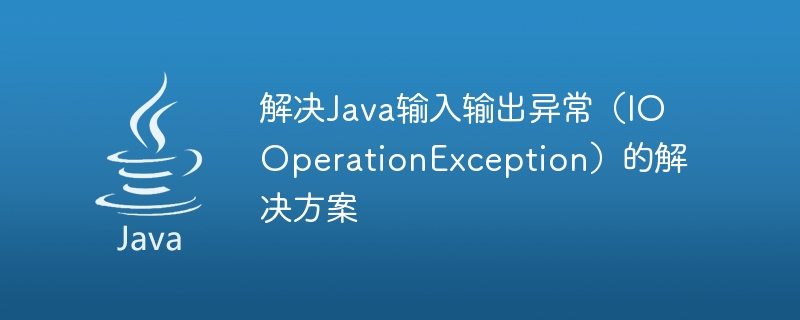Home >Java >javaTutorial >Solution to Java input and output exception (IOOperationException)
Solution to Java input and output exception (IOOperationException)
- WBOYWBOYWBOYWBOYWBOYWBOYWBOYWBOYWBOYWBOYWBOYWBOYWBOriginal
- 2023-08-19 23:46:511605browse

Solution to Java input and output exception (IOOperationException)
In Java programming, input and output exception (IOOperationException) is often encountered, which refers to the file Abnormalities that occur during IO-related operations such as reading and writing, network communication, etc. IO operations involve interaction with external resources, so exceptions are relatively common in IO operations. This article will introduce some common IO exceptions and their solutions, and demonstrate how to handle these exceptions through code examples.
1. Common IO exceptions
- FileNotFoundException
FileNotFoundException means that when trying to open a file, the system cannot find the specified file. This may be caused by a wrong file path, non-existent file, or insufficient file permissions. This problem can be solved by checking whether the file path is correct, confirming whether the file exists, and checking the access permissions of the file.
Code example:
try {
File file = new File("path/to/file.txt");
FileReader fr = new FileReader(file);
// 在这里处理文件读取操作
} catch (FileNotFoundException e) {
e.printStackTrace();
// 处理异常情况,如显示错误信息等
}- IOException
IOException refers to a general exception that occurs during input and output operations. It is the parent class of FileNotFoundException. It may be caused by files being occupied, network communication interruption, equipment failure, etc. Normally, you can catch IOException and handle it according to the specific situation.
Code example:
try {
FileInputStream fis = new FileInputStream("path/to/file.txt");
// 在这里处理文件输入操作
} catch (IOException e) {
e.printStackTrace();
// 处理异常情况,如显示错误信息等
}- SocketException
SocketException refers to an exception that occurs during network communication with the server. It may be caused by network connection interruption, server shutdown, timeout, etc. This problem can be solved by reconnecting to the server, adding timeout processing, etc.
Code example:
try {
Socket socket = new Socket("serverip", 8080);
// 在这里处理与服务器的通信操作
} catch (SocketException e) {
e.printStackTrace();
// 处理异常情况,如显示错误信息等
}2. Solution
- Use try-catch statement to handle exceptions
When writing IO operation code, you can Use try-catch statements to catch exceptions that may occur and handle exceptions in the catch block. This ensures that the program continues to execute when an exception occurs and avoids program crashes.
try {
// 执行可能发生异常的IO操作
} catch (IOException e) {
e.printStackTrace();
// 处理异常情况,如显示错误信息等
}- Use finally block to release resources
When performing IO operations, you need to open and close resources such as files and network connections. To ensure that resources are released correctly, you can use a finally block to release resources even if an exception occurs.
FileReader fr = null;
try {
File file = new File("path/to/file.txt");
fr = new FileReader(file);
// 在这里处理文件读取操作
} catch (FileNotFoundException e) {
e.printStackTrace();
// 处理异常情况,如显示错误信息等
} finally {
if (fr != null) {
try {
fr.close();
} catch (IOException e) {
e.printStackTrace();
}
}
}- Use the try-with-resources statement of Java8
Starting from Java 7, the try-with-resources statement was introduced, which can automatically release resources that implement the Closeable interface. When using try-with-resources, you no longer need to manually close resources, the system will automatically close them.
try (FileReader fr = new FileReader("path/to/file.txt")) {
// 在这里处理文件读取操作
} catch (IOException e) {
e.printStackTrace();
// 处理异常情况,如显示错误信息等
}Through the above solutions, we can effectively handle common IO exceptions and ensure the stability and reliability of the program. In actual development, IO exceptions can be better handled by choosing an appropriate solution according to the specific situation and combining it with the error handling mechanism. I hope this article will be helpful to readers in solving Java input and output exceptions.
The above is the detailed content of Solution to Java input and output exception (IOOperationException). For more information, please follow other related articles on the PHP Chinese website!

